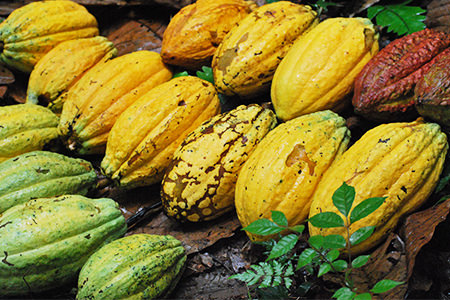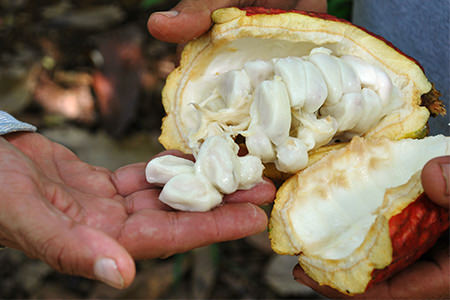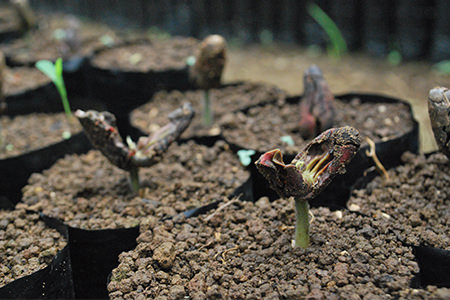All About Chocolate
Welcome to “All About Chocolate” — the place for fun facts and answers to all your cocoa-related questions:
Learn more about topics including the different types of chocolate (milk, white, and dark), a brief history of chocolate, the difference between caffeine and theobromine, and the anatomy of a chocolate truffle. And as always, feel free to ask us your own questions, too!
A Few Interesting Facts About Chocolate

Theobroma cacao is the scientific name of the cacao tree, and means “food of the gods.”
Cacao grows within 20 degrees of the Equator, at low elevations; it thrives on year-round moisture, heat, and shade.
Pods grow directly from the trunk or limbs of the cacao tree. They produce all year long, though typically there are two annual harvests.
As pods ripen, they turn varying shades of orange, yellow, and red.
A cacao tree is growing right here in Burlington, VT! (It lives in a greenhouse at the University of Vermont campus.)
Cacao yields are small and labor intensive — in part because no machine exists to harvest it, so everything is done by hand.
Cacao’s birthplace is South America (the Upper Amazon Basin), from which it spread east. That's the mirror image of coffee, which originated in Africa (Ethiopia) and then traveled westward.
The cacao tree is covered in flowers, which are pollinated by a tiny midge (rather than a bee). Successfully pollinated flowers bear fruit, and that fruit becomes the oval cacao pod.

- The cocoa or cacao “bean” is actually a seed that grows inside its fruit pod. There are anywhere from 30 to 50 seeds, each about the size of an olive, inside one pod. The seeds are surrounded by a milky-white pulp, also called the pith or baba.

Humans have used cacao as a food for at least 3,000 years. A type of cacao wine, made from the fermented baba, predates by at least 500 years the more famous spicy chocolate drink of Mayan kings, which was made from the cacao seed, a.k.a. “bean.”
- Cacao beans undergo fermentation (followed by drying and roasting). So it’s no wonder chocolate pairs so well with other fermented foods like cheese, beer, and wine. (We have yet to try it with pickles...)
The “nib” is the inside of the bean, separated from its outer shell (typically after roasting), then ground into a paste. (At right, nibs are added to a “mélangeur-broyeur,” or mixer-grinder.)
That paste is called cocoa mass (in Europe) or cocoa liquor (in the U.S.). In spite of the name, there is no alcohol in cocoa liquor.

Cocoa liquor can be placed under high pressure to yield cocoa powder (or “cake”) and cocoa butter. Or it can be slowly ground and mixed, while adding sugar and additional cocoa butter, to make chocolate.
Cocoa “butter” (also called Theobroma oil) has no dairy in it. It’s a vegetable fat, pale yellow in color, which is naturally present in cacao.

Chocolate liquor/mass is liquid at temperatures above the melting point of cocoa butter (95°F).
Starting from seed, it takes five years to grow a cacao tree that will produce pods. (Seeds germinating in Guatemala, at left.)
- “Cocoa” vs. “cacao” — there are different schools on how these terms should be used. Some say “cacao” applies to the farm/origin level (pods, seeds, trees), and “cocoa” is accurate once the bean is fermented and dried (some say only once it's roasted). Others insist it’s “cocoa” only if it's been finished (into cocoa mass/liquor) or powdered (separated from the cocoa butter). Many use the terms “cacao” and “cocoa” interchangeably.
Dutched cocoa — what is it? “Dutching” is an alkalizing process which reduces the acidity of cocoa powder, makes it darker in color, and milder in flavor (yet more chocolatey), which is why many baked goods call for dutched cocoa. It also helps cocoa powder stay in suspension longer in liquids, which is why hot cocoa mixes are often made with dutched cocoa.
And yes, it's called the “Dutch process” because it was invented, in the 1800s, by famed Dutch chemist and chocolate innovator Coenraad Johannes van Houten.